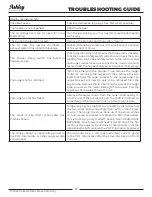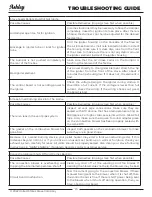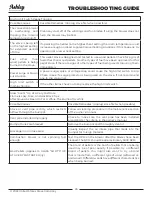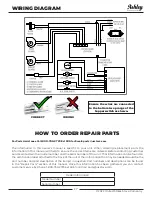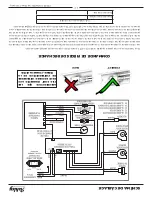
18
© 2022 United States Stove Company
MAINTENANCE
SMOKE & CO MONITORS
Burning wood naturally produces smoke and
carbon monoxide(CO) emissions. CO is a poisonous
gas when exposed to elevated concentrations
for extended periods of time. While the modern
combustion systems in heaters drastically reduce
the amount of CO emitted out the chimney,
exposure to the gases in closed or confined areas
can be dangerous. Make sure you stove gaskets
and chimney joints are in good working order and
sealing properly to ensure unintended exposure. It
is recommended that you use both smoke and CO
monitors in areas having the potential to generate
CO.
CHECK & CLEAN THE HOPPER
Check the hopper periodically to determine if there
is any sawdust (fines) that is building up in the feed
system or pellets that are sticking to the hopper
surface. Clean as needed.
DOOR & GLASS GASKETS
Inspect the main door and glass window gaskets
periodically. The main door may need to be removed
to have frayed, broken, or compacted gaskets
replaced by your authorized dealer. This unit’s door
uses a 3/4” diameter rope gasket.
BLOWER MOTORS
Clean the air holes on the motors of both the
exhaust and distribution blowers annually. Remove
the exhaust blower from the exhaust duct and
clean out the internal fan blades as part of your fall
start-up. If you have indoor pets your power motors
should be inspected monthly to make sure they
are free of animal hair build up. Animal hair build
up in blowers can result in poor performance or
unforeseen safety hazards.
PAINTED SURFACES
Painted surfaces may be wiped down with a damp
cloth. If scratches appear, or you wish to renew your
paint, contact your authorized dealer to obtain a
can of suitable high-temperature paint.
GLASS
We recommend using a high-quality glass cleaner.
Should a buildup of creosote or carbon accumulate,
you may wish to use 000 steel wool and water to
clean the glass. DO NOT use abrasive cleaners. DO
NOT perform the cleaning while the glass is HOT.
Do not attempt to operate the unit with broken
glass. Replacement glass may be purchased from
your U.S. Stove dealer. If the glass is broken, follow
these removal procedures:
1.
Once the heater has cooled, remove the door
from the heater.
2.
Remove the rope gasket from the door followed
by the nuts holding the glass retainer in place.
3.
While wearing gloves, carefully remove any
loose pieces of glass from the door frame.
4. Replace the glass and gasket, making sure the
gasket runs the full perimeter of the glass edge.
5. Re-install the retainer and eight nuts and rope
gasket using high-temperature silicone to
adhere the gasket to the door.
6. Never use substitute materials for the glass.
DO NOT abuse the door glass by striking, slamming,
or similar trauma. Do not operate the stove with the
glass removed, cracked, or broken.
FALL START UP
Prior to starting the first fire of the heating season,
check the outside area around the exhaust and air
intake systems for obstructions. Clean and remove
any fly ash from the exhaust venting system. Clean
any screens on the exhaust system and on the
outside air intake pipe. Turn all of the controls on
and make sure that they are working properly. This
is also a good time to give the entire stove a good
cleaning throughout.
SPRING SHUTDOWN
After the last burn in the spring, remove any
remaining pellets from the hopper and the auger
feed system. Scoop out the pellets and then run
the auger until the hopper is empty and pellets
stop flowing (this can be done by pressing the “ON”
button with the viewing door open). Vacuum out
the hopper. Thoroughly clean the burn pot, and
firebox. It may be desirable to spray the inside of
the cleaned hopper with an aerosol silicone spray
if your stove is in a high humidity area. The exhaust
system should be thoroughly cleaned.
Содержание AP5622
Страница 30: ...30 2022 United States Stove Company NOTES ...



















